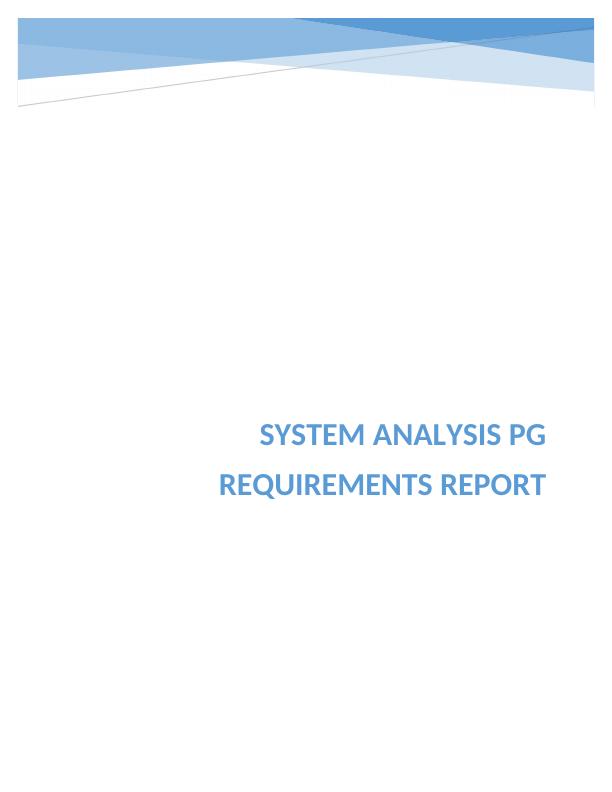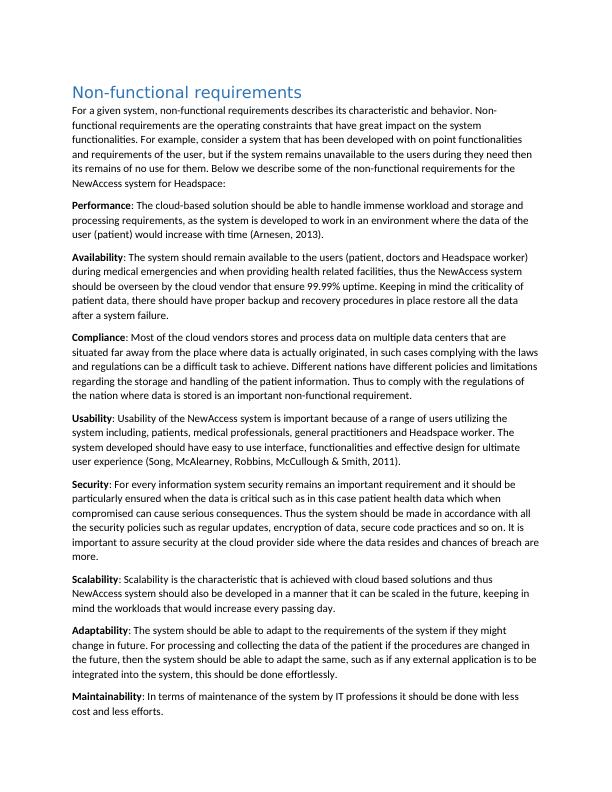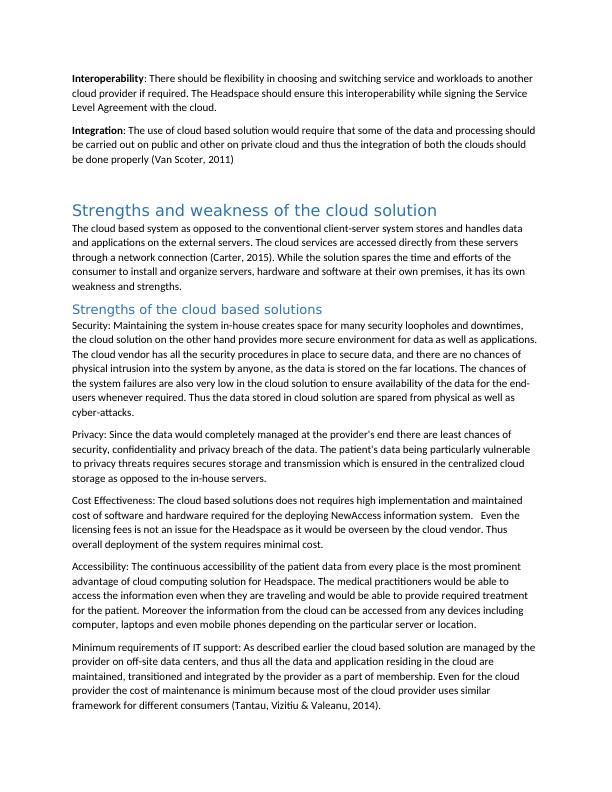Non-functional requirements for NewAccess system for Headspace
6 Pages2340 Words74 Views
Added on 2023-03-17
About This Document
This document describes the non-functional requirements for the NewAccess system for Headspace, including performance, availability, compliance, usability, security, scalability, adaptability, maintainability, interoperability, and integration.
Non-functional requirements for NewAccess system for Headspace
Added on 2023-03-17
ShareRelated Documents
SYSTEM ANALYSIS PG
REQUIREMENTS REPORT
REQUIREMENTS REPORT

Non-functional requirements
For a given system, non-functional requirements describes its characteristic and behavior. Non-
functional requirements are the operating constraints that have great impact on the system
functionalities. For example, consider a system that has been developed with on point functionalities
and requirements of the user, but if the system remains unavailable to the users during they need then
its remains of no use for them. Below we describe some of the non-functional requirements for the
NewAccess system for Headspace:
Performance: The cloud-based solution should be able to handle immense workload and storage and
processing requirements, as the system is developed to work in an environment where the data of the
user (patient) would increase with time (Arnesen, 2013).
Availability: The system should remain available to the users (patient, doctors and Headspace worker)
during medical emergencies and when providing health related facilities, thus the NewAccess system
should be overseen by the cloud vendor that ensure 99.99% uptime. Keeping in mind the criticality of
patient data, there should have proper backup and recovery procedures in place restore all the data
after a system failure.
Compliance: Most of the cloud vendors stores and process data on multiple data centers that are
situated far away from the place where data is actually originated, in such cases complying with the laws
and regulations can be a difficult task to achieve. Different nations have different policies and limitations
regarding the storage and handling of the patient information. Thus to comply with the regulations of
the nation where data is stored is an important non-functional requirement.
Usability: Usability of the NewAccess system is important because of a range of users utilizing the
system including, patients, medical professionals, general practitioners and Headspace worker. The
system developed should have easy to use interface, functionalities and effective design for ultimate
user experience (Song, McAlearney, Robbins, McCullough & Smith, 2011).
Security: For every information system security remains an important requirement and it should be
particularly ensured when the data is critical such as in this case patient health data which when
compromised can cause serious consequences. Thus the system should be made in accordance with all
the security policies such as regular updates, encryption of data, secure code practices and so on. It is
important to assure security at the cloud provider side where the data resides and chances of breach are
more.
Scalability: Scalability is the characteristic that is achieved with cloud based solutions and thus
NewAccess system should also be developed in a manner that it can be scaled in the future, keeping in
mind the workloads that would increase every passing day.
Adaptability: The system should be able to adapt to the requirements of the system if they might
change in future. For processing and collecting the data of the patient if the procedures are changed in
the future, then the system should be able to adapt the same, such as if any external application is to be
integrated into the system, this should be done effortlessly.
Maintainability: In terms of maintenance of the system by IT professions it should be done with less
cost and less efforts.
For a given system, non-functional requirements describes its characteristic and behavior. Non-
functional requirements are the operating constraints that have great impact on the system
functionalities. For example, consider a system that has been developed with on point functionalities
and requirements of the user, but if the system remains unavailable to the users during they need then
its remains of no use for them. Below we describe some of the non-functional requirements for the
NewAccess system for Headspace:
Performance: The cloud-based solution should be able to handle immense workload and storage and
processing requirements, as the system is developed to work in an environment where the data of the
user (patient) would increase with time (Arnesen, 2013).
Availability: The system should remain available to the users (patient, doctors and Headspace worker)
during medical emergencies and when providing health related facilities, thus the NewAccess system
should be overseen by the cloud vendor that ensure 99.99% uptime. Keeping in mind the criticality of
patient data, there should have proper backup and recovery procedures in place restore all the data
after a system failure.
Compliance: Most of the cloud vendors stores and process data on multiple data centers that are
situated far away from the place where data is actually originated, in such cases complying with the laws
and regulations can be a difficult task to achieve. Different nations have different policies and limitations
regarding the storage and handling of the patient information. Thus to comply with the regulations of
the nation where data is stored is an important non-functional requirement.
Usability: Usability of the NewAccess system is important because of a range of users utilizing the
system including, patients, medical professionals, general practitioners and Headspace worker. The
system developed should have easy to use interface, functionalities and effective design for ultimate
user experience (Song, McAlearney, Robbins, McCullough & Smith, 2011).
Security: For every information system security remains an important requirement and it should be
particularly ensured when the data is critical such as in this case patient health data which when
compromised can cause serious consequences. Thus the system should be made in accordance with all
the security policies such as regular updates, encryption of data, secure code practices and so on. It is
important to assure security at the cloud provider side where the data resides and chances of breach are
more.
Scalability: Scalability is the characteristic that is achieved with cloud based solutions and thus
NewAccess system should also be developed in a manner that it can be scaled in the future, keeping in
mind the workloads that would increase every passing day.
Adaptability: The system should be able to adapt to the requirements of the system if they might
change in future. For processing and collecting the data of the patient if the procedures are changed in
the future, then the system should be able to adapt the same, such as if any external application is to be
integrated into the system, this should be done effortlessly.
Maintainability: In terms of maintenance of the system by IT professions it should be done with less
cost and less efforts.

Interoperability: There should be flexibility in choosing and switching service and workloads to another
cloud provider if required. The Headspace should ensure this interoperability while signing the Service
Level Agreement with the cloud.
Integration: The use of cloud based solution would require that some of the data and processing should
be carried out on public and other on private cloud and thus the integration of both the clouds should
be done properly (Van Scoter, 2011)
Strengths and weakness of the cloud solution
The cloud based system as opposed to the conventional client-server system stores and handles data
and applications on the external servers. The cloud services are accessed directly from these servers
through a network connection (Carter, 2015). While the solution spares the time and efforts of the
consumer to install and organize servers, hardware and software at their own premises, it has its own
weakness and strengths.
Strengths of the cloud based solutions
Security: Maintaining the system in-house creates space for many security loopholes and downtimes,
the cloud solution on the other hand provides more secure environment for data as well as applications.
The cloud vendor has all the security procedures in place to secure data, and there are no chances of
physical intrusion into the system by anyone, as the data is stored on the far locations. The chances of
the system failures are also very low in the cloud solution to ensure availability of the data for the end-
users whenever required. Thus the data stored in cloud solution are spared from physical as well as
cyber-attacks.
Privacy: Since the data would completely managed at the provider's end there are least chances of
security, confidentiality and privacy breach of the data. The patient's data being particularly vulnerable
to privacy threats requires secures storage and transmission which is ensured in the centralized cloud
storage as opposed to the in-house servers.
Cost Effectiveness: The cloud based solutions does not requires high implementation and maintained
cost of software and hardware required for the deploying NewAccess information system. Even the
licensing fees is not an issue for the Headspace as it would be overseen by the cloud vendor. Thus
overall deployment of the system requires minimal cost.
Accessibility: The continuous accessibility of the patient data from every place is the most prominent
advantage of cloud computing solution for Headspace. The medical practitioners would be able to
access the information even when they are traveling and would be able to provide required treatment
for the patient. Moreover the information from the cloud can be accessed from any devices including
computer, laptops and even mobile phones depending on the particular server or location.
Minimum requirements of IT support: As described earlier the cloud based solution are managed by the
provider on off-site data centers, and thus all the data and application residing in the cloud are
maintained, transitioned and integrated by the provider as a part of membership. Even for the cloud
provider the cost of maintenance is minimum because most of the cloud provider uses similar
framework for different consumers (Tantau, Vizitiu & Valeanu, 2014).
cloud provider if required. The Headspace should ensure this interoperability while signing the Service
Level Agreement with the cloud.
Integration: The use of cloud based solution would require that some of the data and processing should
be carried out on public and other on private cloud and thus the integration of both the clouds should
be done properly (Van Scoter, 2011)
Strengths and weakness of the cloud solution
The cloud based system as opposed to the conventional client-server system stores and handles data
and applications on the external servers. The cloud services are accessed directly from these servers
through a network connection (Carter, 2015). While the solution spares the time and efforts of the
consumer to install and organize servers, hardware and software at their own premises, it has its own
weakness and strengths.
Strengths of the cloud based solutions
Security: Maintaining the system in-house creates space for many security loopholes and downtimes,
the cloud solution on the other hand provides more secure environment for data as well as applications.
The cloud vendor has all the security procedures in place to secure data, and there are no chances of
physical intrusion into the system by anyone, as the data is stored on the far locations. The chances of
the system failures are also very low in the cloud solution to ensure availability of the data for the end-
users whenever required. Thus the data stored in cloud solution are spared from physical as well as
cyber-attacks.
Privacy: Since the data would completely managed at the provider's end there are least chances of
security, confidentiality and privacy breach of the data. The patient's data being particularly vulnerable
to privacy threats requires secures storage and transmission which is ensured in the centralized cloud
storage as opposed to the in-house servers.
Cost Effectiveness: The cloud based solutions does not requires high implementation and maintained
cost of software and hardware required for the deploying NewAccess information system. Even the
licensing fees is not an issue for the Headspace as it would be overseen by the cloud vendor. Thus
overall deployment of the system requires minimal cost.
Accessibility: The continuous accessibility of the patient data from every place is the most prominent
advantage of cloud computing solution for Headspace. The medical practitioners would be able to
access the information even when they are traveling and would be able to provide required treatment
for the patient. Moreover the information from the cloud can be accessed from any devices including
computer, laptops and even mobile phones depending on the particular server or location.
Minimum requirements of IT support: As described earlier the cloud based solution are managed by the
provider on off-site data centers, and thus all the data and application residing in the cloud are
maintained, transitioned and integrated by the provider as a part of membership. Even for the cloud
provider the cost of maintenance is minimum because most of the cloud provider uses similar
framework for different consumers (Tantau, Vizitiu & Valeanu, 2014).

End of preview
Want to access all the pages? Upload your documents or become a member.
Related Documents
Headspace NewAccess Projectlg...
|12
|2020
|277
System Analysis and Design: Cloud Computinglg...
|13
|2906
|228
Headspace Newaccess Project 2022lg...
|12
|2731
|5
System Analysis for NewAccess Mental Health Projectlg...
|12
|2233
|364
System Analysis PGlg...
|10
|2102
|94
System Analysislg...
|11
|2476
|437
